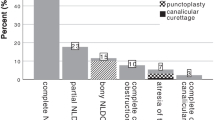Abstract
This study aimed to examine the rate of symptomatic improvement of congenital nasolacrimal duct obstruction (CNLDO) in infants treated with conservative management within the first year of age. Other purpose of the study is to emphasize the relationship between spontaneous resolution time and effective lacrimal sac massage. Thirty-one infants were diagnosed to have CNLDO by an ophthalmologist prior to 3 months of age. In this study, 36 eyes of 31 patients were included with CNLDO. The patients were divided into two groups. Group 1 (28 eyes of 24 patients) was consisted of the patients who were applied effective lacrimal sac massage regularly during the follow-up period, and patients whose parents did not apply a regular lacrimal passage regularly were accepted as group 2 (8 eyes of 7 patients). Thirty-three eyes of 31 patients (18 rights and 15 left) successfully resolved with only conservative management (91.6 %). In these thirty-three eyes, one eye (3 %) resolved between 0 and 3 months, fourteen eyes (42.5 %) resolved between 4 and 6 months, eleven eyes (33.3 %) resolved between 7 and 9 months, and seven eyes (21.2 %) resolved between 10 and 12 months. CNLDO was resolved in 27 (96.2 %) of 28 eyes in group 1, and in group 2, six eyes (77.7 %) had resolvement. This difference was statistically significant (p = 0.001). The mean age of resolution was 6.8 ± 1.88 months in group 1, 10.3 ± 1.5 months in group 2 (p < 0.001). In light of our study, we believe that conservative management of CNLDO is highly successful. Our study provided a possible objective explanation for the efficacy of lacrimal sac massage. Emphasizing the importance of the massage to parents and describing in detail can reduce the risk of unnecessary surgical interventions.
Similar content being viewed by others
References
Caputo GM, Appelbaum PC, Liu HH (1993) Infections due to penicillin-resistant pneumococci. Clinical, epidemiologic, and microbiologic features. Arch Intern Med 153(11):1301–1310
Cassidy TC (1952) Developmental anatomy of the nasolacrimal duct. Arch Ophthalmol 47(2):141–158
Crigler LW (1923) The treatment of congenital dacryocystitis. JAMA 81:23–24
Kakizaki H, Takahashi Y, Kinoshita S, Shiraki K, Iwaki M (2008) The rate of symptomatic improvement of congenital nasolacrimal duct obstruction in Japanese infants treated with conservative management during the 1st year of age. Clin Ophthalmol 2(2):291–294
Kerstein RC (1996). Congenital lacrimal abnormalities In: Principles and practice of ophthalmic plastic and reconstructive surgery. W B Saunders Company. 2 731–747
Kodsi S (2006) Community-acquired methicillin-resistant Staphylococcus aureus in association with chronic dacryocystitis secondary to congenital nasolacrimal duct obstruction. J AAPOS 10(6):583–584
Kushner BJ (1982) Congenital nasolacrimal system obstruction. Arch Ophthalmol 100(4):597–600
MacEwen CJ, Young JDH (1991) Epiphora during the first year of life. Eye 5(Pt 5):596–600
MacEwen CJ, Phillips MG, Young JD (1994) Value of bacterial culturing in the course of congenital nasolacrimal duct (NLD) obstruction. J Pediatr Ophthalmol Strabismus 31(4):246–250
Nelson LR, Calhoun JH, Menduke H (1985) Medical management of congenital nasolacrimal duct obstruction. Ophthalmology 92(9):1187–1190
Noda S, Hayasaka S, Setogawa T (1991) Congenital nasolacrimal duct obstruction in Japanese infants: its incidence and treatment with massage. J Pediatr Ophthalmol Strabismus 28(1):20–22
Nucci P, Capoferri C, Alfarano R, Brancato R (1989) Conservative management of nasolacrimal duct obstruction. J Pediatr Ophthalmol Strabismus 26(1):39–43
Paul TO (1985) Medical management of congenital nasolacrimal duct obstruction. J Pediatr Ophthalmol Strabismus 22(2):68–70
PEDIG (2012). A randomized trial comparing the cost-effectiveness of 2 approaches for treating unilateral nasolacrimal duct obstruction. Arch Ophthalmol; 130(12):1525–1533
Peterson RA, Robb RM (1978) The course of congenital obstruction of the naso-lacrimal duct. J Pediatr Ophthalmol Strabismus 15(4):246–250
Piest KL, Katowitz JA (1991) Treatment of congenital nasolacrimal duct obstruction. Ophthalmol Clin North Am 4:201–209
Robb RM (2001) Congenital nasolacrimal duct obstruction. Ophthalmol Clin North Am 14(3):443–446
Welham RAN, Hughes SM (1985) Lacrimal surgery in children. Am J Ophthalmol 99(1):27–34
Jensen OL, Gluud BS (1985) Bacterial growth in the conjunctival sac and the local defence of the outer eye. Acta Ophthalmol 63:80–82
Mannis MJ (1997) Bacterial conjunctivitis. In: Tasman W, Jaeger EA (eds) Duane’s clinical ophthalmology. JB Lippincott, Philadelphia, pp 1–7
Usha K, Smitha S, Shah N, Lalitha P, Kelkar R (2006) Spectrum and the susceptibilities of microbial isolates in cases of congenital nasolacrimal duct obstruction. J AAPOS 10(5):469–472
Gerkowicz M, Koziol-Montewka M, Pietras´-Trazpiel M, Kosior- Jarecka E, Szczepanik A, Latalska M (2005) Identification of bacterial flora of conjunctival sac in congenital nasolacrimal duct obstruction in children. Klin Oczna 107(1–3):83–85
Kuchar A, Lukas J, Steinkogler FJ (2000) Bacteriology and antibiotic therapy in congenital nasolacrimal duct obstruction. Acta Ophthalmol Scand 78(6):694–698
Bareja U, Ghose S (1990) Clinicobacteriological correlates of congenital dacryocystitis. Indian J Ophthalmol 38(2):66–69
Kim YS, Moon SC, Yoo KW (2000) Congenital nasolacrimal duct obstruction: irrigation or probing. Korean J Ophthalmol 14(2):90–96
MacEwen CJ, Phillips MG, Young JD (1994) Value of bacterial culturing in the course of congenital nasolacrimal duct (NLD) obstruction. J Pediatr Ophthalmol Strabismus 31(4):246–250
Young JDH, MacEwen CJ (1997) Managing congenital lacrimal obstruction in general practice. BMJ 315(7103):293–296
Zwaan J (1997) Treatment of congenital nasolacrimal duct obstruction before and after the age of 1 year. Ophthalmic Surg Lasers 28(11):932–936
Author information
Authors and Affiliations
Corresponding author
Ethics declarations
Conflicts of interest
None.
Rights and permissions
About this article
Cite this article
Karti, O., Karahan, E., Acan, D. et al. The natural process of congenital nasolacrimal duct obstruction and effect of lacrimal sac massage. Int Ophthalmol 36, 845–849 (2016). https://doi.org/10.1007/s10792-016-0208-5
Received:
Accepted:
Published:
Issue Date:
DOI: https://doi.org/10.1007/s10792-016-0208-5




